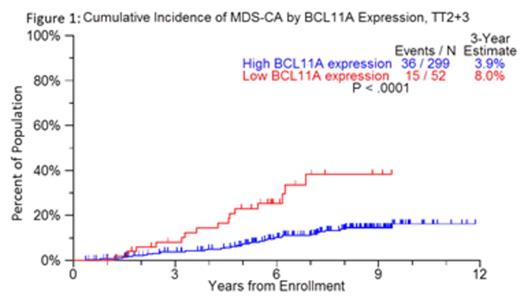Abstract
Prolonged survival of myeloma patients on Total Therapy regimens including IMIDS and novel agents has been associated with increased incidence of treatment-related myelodysplastic syndrome and acute leukemia (t-MDS/AL). MDS cytogenetic abnormalities (MDS-CAs) are often observed prior to t-MDS/AL development. Among 1,080 patients on TT2 and TT3 protocols, MDS-CA occurred in 11% and t-MDS/AML in 3%. Risk features of MDS-CA included TT3b treatment, age ³65 yr, male sex, elevated B2M, and MM relapse. Lower doses of CD34 HSCs applied with first transplants raised the probability of MDS-CAs, and lower CD34 HSCs dosing was an independent contributor to MDS-CAs and clinical t-MDS (Usmani et al., 2013). Although patients with MDS-CAs do not always develop t-MDS/AML, the phenomenon, also recognized in other tumors, requires understanding and development of preventive measures. We analyzed gene expression profiling (GEP) of bone marrow core biopsies at diagnosis from patients enrolled in our TT2 (n=88) and TT3 (n=263; training set) trials to identify genes associated with time to MDS-CA. Univariate Cox regression identified BCL11A as the only gene with expression associated with the time to development of MDS-CA (q <0.1). Incidence of MDS-CA for MM patients enrolled in TT2 and TT3 is 11% (Usmani et al., 2013); 3-year estimate of patients with low BCL11A expression is 8% vs. 3.9% for those with higher expression (Figure 1). Univariate analysis of baseline variables linked shorter time to MDS-CA with Age ≥ 65 yr, B2M > 5.5 mg/L, GEP70-defined high risk and low BCL11A expression, while female sex was linked with longer time to MDS-CA development. In multivariate analysis, females retained independent prognostic significance for time to MDS-CA (HR-0.41, p 0.006), as did B2M > 5.5 mg/L (HR-1.95, p=0.038) and BCL11A expression <10.323 (HR-3.24, p <0.001). In addition to its role in normal hematopoietic development (Yu et.al., 2012), BCL11A is a central transcription factor in normal erythropoiesis (Xu et.al. 2012), and differences in its expression may reflect abnormal erythropoiesis. Indeed, lower Hb levels before HSC mobilization was associated with MDS-CA development in MM patients (Papanikolaou et al., 2013) while BCL11A expression is lower in core biopsies from MM patients than in those from healthy donors. BCL11A expression correlated with a set of genes associated with erythropoiesis (r>0.55) (e.g., GYPA, TFRC, RHAG, TRIM10, ANK1, SPTA1). BM cell fractions from MM patients were purified using MACS and FACS and BCL11A expression was analyzed by qRT-PCR demonstrating that BCL11A is highly expressed in CD19+ B cells and CD235a+ erythroid cells, intermediately expressed in CD34+ HSPCs, and absent in CD3+ T cells and CD15+ myeloid cells. BCL11A expression in paired biopsies and CD138-selected PCs does not correlate, further demonstrating that BCL11A expression originates in the MM microenvironment. As suppression of hematopoiesis is common to MDS and MM, we determined whether loss of BCL11A was associated with survival independent of MDS-CA status. Lower BCL11A expression in bone biopsies was associated with poor overall survival of patients on the TT2 protocol (p=0.0182) and TT3 protocol (p=0.0015). Taken together, these data demonstrate that low BCL11A expression in newly diagnosed MM is an independent predictor of early MDS-CA development, and is associated with altered hematopoiesis and poor overall survival, and may be a biomarker of t-MDS/AML risk.
No relevant conflicts of interest to declare.
Author notes
Asterisk with author names denotes non-ASH members.


This feature is available to Subscribers Only
Sign In or Create an Account Close Modal